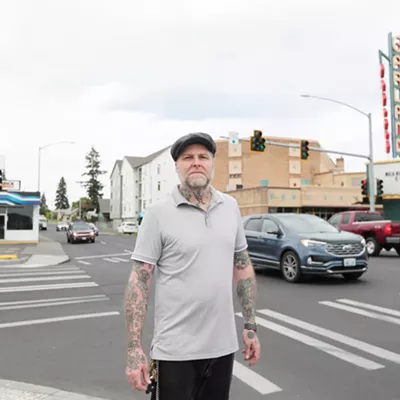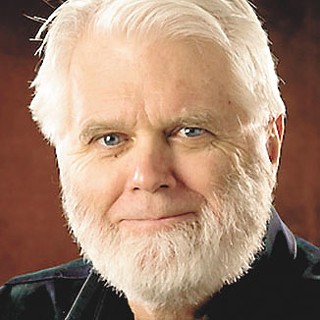Jim Frank is nothing if not optimistic. In the early ’80s, Frank, who has chemical engineering and law degrees from Gonzaga, founded Greenstone Homes. He set up shop in Liberty Lake. At the time, all that existed at the Liberty Lake freeway exit was a small shopping center and an executive golf course, surrounded by most of Spokane’s then-nascent technology industry.
To what would become the new town of Liberty Lake, Frank brought an intuitive sense of urban design, a carefully diagnosed market strategy, boundless energy and boyhood memories. More on this in a bit.
Greenstone’s success over these years, especially its resilience since the housing meltdown, has been remarkable. “In 2008,” reports Frank, “we sold and closed 135 homes. This was down slightly from 2007, but it was the most by a single builder in the region.” He predicts 2009 will be even better.
He’s not kidding. His neighborhood developments (and that’s what they are) have experienced next to no foreclosures, remain free of “flippers” and appear to be bastions of domestic stability. Few “for sale” signs appear. Construction is continuing in the newer developments, perhaps at a somewhat slower pace.
Frank acknowledges that Liberty Lake remains a suburban-lifestyle town. Less than 20 percent of the workforce calls Liberty Lake the “office” or “lab” or “line.” The little municipality remains automobile centered. That acknowledged, Frank has tried to mitigate the car by incorporating into his developments design features that a “New Urbanist” would recognize.
Here’s a sample:
Mixed residential housing: In Frank’s developments you find single-family dwellings right alongside town houses, duplexes and four-plexes. Traditional zoning — like that in Spokane — does not permit this. Frank thinks that limiting mixed housing was always a bad idea. The net result of his approach is more diversity, higher density and a pedestrian-friendlier environment.
Front porches: Frank has brought back the front porch, which, he laments, is almost impossible to pull off in Spokane due, again, to zoning and building codes. And as we drive through one of his newer neighborhoods, Frank smiles as he waves to several Liberty Lake citizens who are sitting on their ample front porches. It was right about here in our tour that Frank began talking about his boyhood memories: “When I think of the perfect neighborhood, I think of the neighborhood I grew up in. I think of Corbin Park [in Spokane].” Corbin Park transported through time to Liberty Lake: That’s what he hopes to accomplish.
Streetscape: Most of our streetscapes struggle, often ignored by developers and besieged by traffic engineers. Not so in Liberty Lake. Frank’s streets incorporate sidewalks and are lined with trees selected for their long life and promised canopy.
Traffic calming: One of Frank’s frustrations with life today is the demise of the alley. Through his developments he has rediscovered what author David Sucher, in City Comforts, calls “an elegant solution to getting the car onto the site without crossing over the sidewalk.”
Garage design: And speaking of garages, Frank hates the protruding garage, described by Yale professor Dolores Hayden in her book The Field Guide to Sprawl, as “snout houses.” Thrusted garages hide the porch and destroy its humane utility.
Walking trails: Frank has connected neighborhoods together with paved trails. And while he is under no illusion that he has created a walking culture, he believes his network of trails encourages just that.
Traffic calming: Frank is proud of his “bulbed” corners. Again from David Sucher: “… moving the curb out into the roadway creates a ‘curb bulb,’ which is a superior, more comfortable spot for the walker crossing the streets and widens the sidewalk. It reduces the distance pedestrians must cross and makes them more prominent and visible to drivers.”
Parks: Spokane has wonderful city parks, from Comstock and the city’s crown jewel, Manito Park on the south side, east to the giant Lincoln Park, back near downtown to Coeur d’Alene and Corbin parks — respectively, in Browne’s Addition and north central — to Audubon Park up north, in the Downriver area. Many designed by the Olmsted Brothers at the start of the 20th century, Spokane’s wonderful city park system remains a lasting monument to the City Beautiful movement.
But have you noticed? No developer since then has thought about providing a park. This is most unfortunate. In The Pattern Language — by consensus, the most important book ever written about built-environment design — author and University of California at Berkeley Professor of Architecture Christopher Alexander writes: “People need green open places to go to; when these are close they use them. But if the greens are more than three minutes away, the distance overwhelms the need.”
Enter Jim Frank. He drives me to his community park. Nicely designed, it comes complete with pavilion, a replica of its more famous ancestor that years ago graced the lakeside. It attracts walkers; throughout the summer, the park hosts events and movies, and the numbers of residents showing up for these events or just to hang out is amazingly high.
But this is only one of many parks Frank has designed and built. Actually, every new development comes complete with a pocket park or maybe something even larger. And all his parks are located about three minutes away from any house in the development.
But that still leaves a few unanswered questions. How has Greenstone managed to minimize the sub-prime mess? And the so-called “flipper” phenomenon of speculation buying? What market niche was he trying to capture? Has he succeeded? I put these questions to Frank.
“We did three things,” he says. “We worked with smaller ‘preferred lenders’ that offered loan products that we approved. This eliminated the predatory practices that got many good borrowers into trouble. Second, we have ‘non-speculation’ agreements that must be signed by the purchaser that requires that they occupy the home.”
And about his market target, Frank observes that — in an area where the average family income is about $54,000 — building houses costing much more than $330,000 forces you into a very small market. Accordingly, most Greenstone homes are priced under $300,000, many in the $250,000 range. Moreover, there is a price range for every qualified buyer.
It is true, Liberty Lake isn’t Corbin Park. Nor is it as integrated or complete a planned community as, say, Reston, Va., or Columbia, Md. But what Frank is doing at Liberty Lake represents a serious and commercially successful effort to bring some semblance of urban design to residential life, even in that sea of standard-form suburbia we call the Spokane Valley.
Frank shows that he understands people are people, that they are social animals, that they like contact, like to get out of their cars, enjoy diversity, are interested in their visual surroundings and thrive when size, scale and design are in harmony.
He insists that what he is doing isn’t really “rocket science,” that everything he knows about urbanism he learned growing up in his beloved Corbin Park neighborhood. ’Tis a pity that more developers and bureaucrats didn’t benefit from the same experience.




















